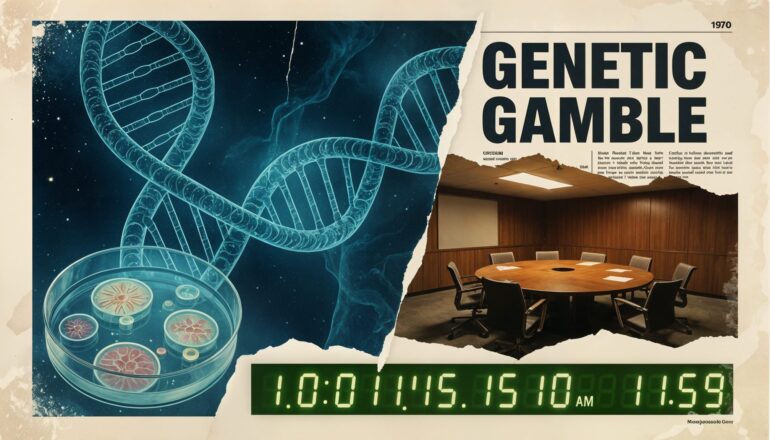The moment scientists feared their own invention might end civilization wasn’t a movie plot—it was 1973.
That was the haunting question facing molecular biologists in 1973. Their answer didn’t just shape research—it rewrote the rules of modern science.
Picture a New Hampshire conference hall, the air thick with burned coffee and a nervous weight that even Nobel laureates had never carried. For the first time, the people decoding life itself wondered whether their own brilliance might spiral beyond control.
This isn’t fiction. It’s the opening scene of a real-world drama so intense, so tangled with moral urgency, that it reads like the ultimate genetic engineering thriller. The story captures the moment scientists stared into the abyss—and chose restraint.
The Birth of Biotech’s Greatest Fear
In 1973 at Stanford, Paul Berg was preparing a bold experiment: fusing DNA from a cancer-causing monkey virus with the harmless bacteria that live inside every human gut.
The method—recombinant DNA—was revolutionary. The risks were terrifying.
What if the engineered bacteria escaped the lab? What if it quietly spread, transforming our gut microbes into cancer-making machines?
These weren’t dystopian fantasies. They were the exact fears voiced by Nobel winners and molecular pioneers themselves.
Berg made the unthinkable choice: he halted his own research. That voluntary pause sent shockwaves through science and set in motion the most remarkable act of collective restraint in modern history.
The Asilomar Gamble: Democracy vs. Expertise
The story’s peak unfolds at the Asilomar Conference in 1975.
For three days, 140 scientists isolated themselves on the fog-shrouded California coast to decide the future of genetic research. Inside Julia Morgan’s timbered chapel, “hawks” and “doves” clashed: some argued for a total ban, others for carefully regulated progress.
James Watson warned, “If we let fear dictate the agenda, we risk smothering discoveries that could save us all.”
Yet the bigger drama came afterward. Communities like Cambridge, Massachusetts, rejected the scientists’ closed-door verdict. Mayor Alfred Vellucci captured public unease with a soundbite: mutant bacteria creeping through the sewers.
It wasn’t just theater—it was democracy demanding a voice in life’s most consequential decisions.
From Caution to Gold Rush
The irony? The safety rules born from fear became the founding framework of the biotech industry itself.
Soon after Asilomar, venture capitalist Robert Swanson and researcher Herbert Boyer shook hands in a San Francisco pub, creating Genentech. What began as an ethical checkpoint became a launchpad for the biotech gold rush.
This paradox sits at the story’s core: were those guidelines an act of responsibility—or brilliant public relations?
Why This Still Matters
Every breakthrough in genetic engineering, synthetic biology, or even artificial intelligence carries the same dilemma. Who decides what’s too dangerous to pursue? Where is the line between progress and peril?
Asilomar set the template that is still used today: experts spot risks, retreat into private meetings, craft voluntary safeguards, and then present their conclusions to a watchful public. From CRISPR to AI, the cycle repeats.
This isn’t just a chapter in DNA history. It’s the hidden playbook for how society absorbs world-changing technology.
The Complete Collection Awaits: Five Hidden Histories That Shaped Our World
This masterful story of genetic engineering is just the beginning. It’s one of five meticulously researched narratives in The Secret History of Science – Volume 1, a collection dedicated to unearthing the pivotal moments when scientific truth collided with human ambition, corporate greed, and the politics of power.
Each story reveals a battle fought in the shadows, with consequences that still ripple through our world today. In this collection, you will uncover:
- The Asilomar Gambit: The full story of how the genetic engineering debate was carefully managed by a scientific elite, shaping our biotech future behind closed doors.
- The Tesla Enigma: A deep dive into why Nikola Tesla’s most radical energy work vanished after his death, leaving a legacy of suppressed inventions and unanswered questions.
- The Merchants of Doubt: The shocking inside story of the tobacco industry’s global deception, armed with their own internal proof of harm while publicly denying the truth.
- A Poisoned World: The chilling history of leaded gasoline, revealing who knew it was a potent neurotoxin and chose decades of silence over public safety.
- The Human Exception: An exploration of how the scientific establishment systematically downplayed animal intelligence to preserve the comforting myth of human exceptionalism.
These aren’t just historical accounts; they are gripping thrillers pulled from the pages of reality.
Ready to uncover the stories that define our modern world?
🧬 Purchase the complete collection and get all five gripping stories that reveal the hidden battles for control over science and society.
🎧 Listen to the podcast series and join our two hosts as they break down each hidden history, offering new perspectives and behind-the-scenes insights.
📺 Watch the video podcast on our YouTube channel and dive into the conversation in the comments.
Some histories weren’t just written—they were buried. It’s time to start digging.

